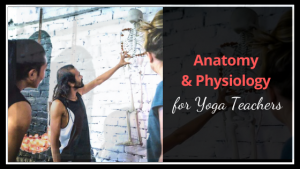Anatomy and Physiology for Yoga Teachers
Yoga is one of the most popular forms of exercise that has a great impact on our physical and mental health.
To understand its impact, it is important to know the inner structure and functioning of the body.
As a yoga teacher or practitioner, you must be familiar with the limitations of each body type and its level of experience.
Therefore teachers must learn about the basics of anatomy and physiology to understand what’s going on in the body and achieve the full benefits of yoga.
What is Yoga Anatomy?
Anatomy is a medical term and it deals with the study of basic structures of the body. Its teaching includes the study of bones, muscles, joints, and other internal organs of the body.
All Yoga teachers need to understand the structure of the human body to increase the effectiveness of asanas and protect the body from injuries.
With this anatomical awareness you will be prepared to deal with injuries in an effective, yet protected manner.
What is Yoga Physiology?
Yoga Physiology is the science that deals with the functioning of the body parts and their specific roles.
Its teaching includes the study of the function of different organs like respiration, reproduction, digestion, osmoregulation, and a lot more.
It is a dynamic study that reveals how different systems in the body function collectively as a single unit that is moved by energy.
Anatomy vs Physiology
The word ‘anatomy’ refers to the ‘structure of body’, while ‘physiology’ refers to ‘function of the body’.
In the anatomy of yoga, you will learn about the detailed structure of different parts and organs of the body.
Whereas in yoga physiology you will be studying the functions of these body parts and organs in a coordinated way.
These two terms are often studied jointly and are incomplete without each other. One needs to know anatomy before acquiring the knowledge of physiology, conversely, only studying anatomy without understanding physiology is simply worthless.
5 Things every Yoga Teacher should know about Anatomy and Physiology
Here are 5 important aspects of anatomy and physiology that every yoga teacher should know:
Understanding Skeletal Structure of the body
A human skeleton consists of 206 bones that support and form the structure of an adult body. However, as a yoga teacher, you should mainly know about the major bones of the body like the legs and the arms.
Another major skeletal structure that the teachers should know about is the spinal cord. Besides being the backbone and support of the skeleton, the spine plays a big role in the anchoring of muscles.
Understanding the skeletal structure will help yoga teachers which poses will be effective on which part of the body.
Understanding the movements of the body
Understanding how the body moves will help in making it stronger, free from injuries, and much more balanced.
Yoga teachers can gain knowledge over this by understanding the three anatomical planes of movement.
Once you understand how these planes work you will be able to determine in which one you feel the utmost comfortable moving your body.
As a yoga teacher, this understanding will help you include poses that will take your students through these planes of movement and lets you decide what works the best for them.
Understanding Muscles of the Body
Along with the bones, teachers should also know about the muscle anatomy of the body. As you move your body into yoga poses all the muscles of the moving joints are working irrespective of the length they’re at.
Learning about the muscular structure in association with body movements will let teachers focus on the effectiveness of asanas for targeting and healing specific groups of muscles.
Major Joints of the Body
A joint is a part of your skeleton where two or more bones meet. Conventionally, joints can be classified as the tissues that attach the two bones.
This may include the cartilage, fibrous tissue, synovial fluid, or any combination of the three. An understanding of the types of joints in a body lets you determine the set of movements that are safe for the body to perform and prevents injuries to the joints.
Understanding Body alignment during Yoga
Understanding and identifying the major bones, muscles, joints, and movements of the body will allow teachers to know how their body functions.
Based on this functional anatomy, teachers will learn how to move their bodies and maintain proper alignment during the yoga poses. Thus this will prevent you from discomfort or injuries caused due to incorrect body posture.
Anatomy education for yoga teachers
Learning about the anatomy of the human body will not only make you a better yogi but also an even better yoga teacher.
As a Yoga instructor, you must be able to help the students thoroughly adjust to yoga poses easily and safely. Some students attending your class might have some prior injuries or other health concerns.
As a yoga teacher, it becomes your duty to ensure the safety of students while they perform poses with you.
Therefore it becomes extremely important to acquaint yourself with each area and function of the body through anatomy education.
Importance of understanding and studying anatomy in yoga teacher training course
If you wish to practice or teach yoga with confidence, and clarity and gain complete knowledge of the body structure then a yoga teacher training course is the right choice for you.
Such courses are primarily designed to teach the anatomy of the body and the effect of yoga exercises on the human body.
Through the study of anatomy in yoga teacher training, you will acquire a deep understanding of the execution and alignment of asanas.
An awareness of yoga anatomy and physiology will add credibility to your teaching and will be very helpful to your prospective yoga students.

